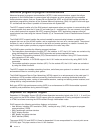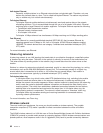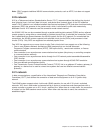
Chapter 10. Common networking standards
These topics introduce the types of common networking standards that are supported by the AS/400
system. See the following topics for more information:
v Local area network standards
v Wide area network standards
Local area network standards
A LAN (local area network) is a communications system that allows interconnection and the sharing of
resources between independent devices within a moderately sized geographic area. These topics
introduce the types of local area networks that are supported by the AS/400 system:
v Asynchronous transfer mode (ATM)
v DDI (distributed data interface) networks
v Ethernet
v Token-ring
v Wireless networks
ATM on AS/400
Asynchronous Transfer Mode (ATM) provides a very fast and flexible network protocol. When used with
LAN emulation, you can run token-ring and Ethernet on ATM to take advantage of ATM’s superior speed,
throughput, and flexibility.
ATM LAN emulation connects LAN clients at multi-megabit-per-second speeds over distances previously
possible only with a wide area network (WAN). LAN emulation makes client connections as they are
needed, without configuring the physical path between the end systems. Switching is the mechanism by
which the network completes connections from one device to another.
The AS/400 asynchronous transfer mode (ATM) network interface (NWI) describes everything that is
common across the ATM physical interface. Each AS/400 ATM input/output adapter (2809 or 2810) may
have one network interface attached. A single line description attaches to the NWI. The line description
can define either an Ethernet or token-ring local area network (LAN) emulation client by using switched
virtual circuit connections, permanent virtual circuit connections, or direct connections.
For more information on ATM, see the topic ATM on AS/400.
Distributed data interface network
FDDI is an optical fiber-based local area network (LAN) that uses the American National Standards
Institute (ANSI) 3T9.5 standard for a token-passing ring media access control (MAC) protocol. Stations,
concentrators, and bridges in a FDDI network are physically connected to one of the counter-rotating rings
or both of the counter-rotating rings. The rings operate at 100 Mbps.
FDDI networks allow devices to be attached to one or both of the rings. Usually only the primary ring in a
FDDI network is active. The secondary ring is used to maintain the network when a dual-access station or
a concentrator becomes inactive.
Ethernet networks
Ethernet is one type of local area network (LAN) topology that is supported by the Operating System/400
licensed program. OS/400 Ethernet provides support for the Digital Equipment Corporation, Intel
Corporation, and Xerox standard (Ethernet Version 2) and the IEEE 802.3 standard.
© Copyright IBM Corp. 1998, 2001 91


















